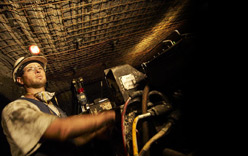The Mining Process
Once a mining lease has been awarded to an operator,
exploration (i.e. evaluation of the resource) takes place, followed by a
planning and development process before excavation or mining begins.
The initial task is to gain access to the seam from the
surface by some means (shafts, drifts, etc – see Access to Seam from
surface section for these terms).
Once access has been gained into the coal seam,
workings are developed by mining a series of roadways (or "headings"). These roadways are tunnels largely, if
not totally, within the seam, usually rectangular in shape though on occasions
they may have an arched or even circular profile. The roadways are connected at
intervals by other roadways known as "cut-throughs", thus forming areas of coal "pillars", most commonly but not always rectangular
in shape. These pillars should be of a size which is stable (i.e. they will not
crush out) for the existing strata/stress conditions and for any future altered
conditions caused by further excavation. The minimum pillar size may be
specified by legislation (e.g. the smallest dimension to be not less than 10%
of the seam depth below surface) but this can usually be varied with approval
of the statutory authority if assessment by appropriate experts indicates there
is no unacceptable risk involved.
The roadways are commonly around 5m wide, and a
maximum width may be specified by legislation (this again may be varied with
approval after assessment of the risk). They are typically driven at 2.5 to
3.5m in height (which accounts for over 95% of all Australian coal mine
roadways). In thinner seams they may be partly driven in roof or floor strata
whilst in thicker seams coal may be left in the immediate roof or floor to
provide a comfortable working height and/or to control roof or floor
conditions. Whatever height is chosen is referred to as the "working height".
Such roadways need to be stable for extended periods
(some for the whole life of the mine) and in most mines this means supports
need to be installed to reinforce the roof and in many mines, the sides
(referred to as "ribs")
and sometimes even the floor strata. This support work is an expensive process,
primarily due to the extent of manual handling and operation involved.
For this reason, such sets of roadways are usually
driven at different locations and in different directions to delineate larger
blocks of coal to be extracted by other means.
The above process is referred to as "first workings" or now more commonly as "development". Provided the pillars remain stable, this
type of mining will not give rise to subsidence at the surface In some mines or
parts of mines first workings is the only type of mining permitted, where
surface or sub-surface structures need to be protected or projected levels of
subsidence are unacceptable. For most mines, however, it would be uneconomic to
operate with first workings only.
For this reason, other methods of mining have been developed
to remove large blocks of coal between areas of first workings, methods which
require minimal "permanent" support or which use temporary, reusable supports.
Usually the coal from these large blocks is extracted while retreating from a
boundary back to the main mine access and the roof strata is allowed to
collapse into the cavity formed, such an area of collapsed roof being known as
a "goaf" (at other
times and places also referred to as a "waste" or "gob"). The plural of "goaf" is usually written as "goaves".
This stage of mining is known as "second workings" or "pillar extraction". Longwall mining is one method of pillar
extraction, now the most common method in use in Australia, and probably
worldwide. Before longwall mining methods had been developed to operate
satisfactorily in most conditions, a lot of pillar extraction was carried out
using continuous miners, and such methods are still in use in places for a
variety of reasons.
Simple Mine Layout Showing 1st & 2nd Workings

